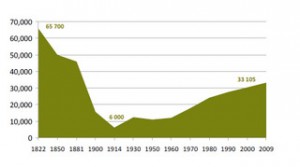Shifting the shores of Champagne
A version of this article first appeared in Australia’s Winestate magazine in July/August 2010.
There’s been a lot of kerfuffle about the proposed expansion of the Champagne delimited region, currently standing at just over 33,000 hectares (ha). At an industry update session earlier this year, Bruno Paillard, President of the commission for communication and the appellation at the CIVC (Comité interprofessionnel du vin de Champagne), (and owner of Champagne Bruno Paillard, explained the process:

Planted surface in Champagne, source: CIVC
In the 18th century it is estimated the champagne region was around 80,000 hectares. At this time the region was producing still wine. Early documents reveal the planted surface in 1822 was 65,700 ha, by which time Champagne was moving from still to sparkling wine production. But after late 19th century devastation by phylloxera, the vineyard area reached its nadir at the beginning of the first world war in 1914, falling to just 6,000 ha. By 2000, it had recovered slowly to 33,105ha.
After decimation by phylloxera, and after the first world war, recovery was slow. The front line had gone through the region, and by the end of the war, two key export markets were closed off: Russia due to the Revolution (1917) and the USA due to prohibition (1920 to 1933). With a brief interlude of the glittering twenties, global recession soon followed in 1929, and the second world war a decade later.
So it was only in the 1950s that people started to replant. If ever there is a wine product associated with a kind economy, at home and abroad, Champagne is it, though war, recession and anti-alcohol lobbies are friends of no wine producer. During the 2009 recession, total Champagne shipments were down 15% on 2008, though shipments to the USA were down 30%, with both this market and Germany falling to their respective early 1990 levels.
But it was in those bright, glittering 1920s that the Appellation d’Origine Contrôlée was set up, along with a map of the region drawn up in 1927. Though it’s unofficial, it is the map still being used today. It listed more than 30,000 ha as being capable of growing vines for Champagne.
Now, in the early 21st century, those unofficial boundaries are bulging and bursting at their braces, as shipments show: in 1950 Champagne shipments were just 33.4 million bottles, and this had grown to 293 million bottles in 2009.
In 2003 INAO, the organisation that oversees appellation legislation, started a study to revisit the Champagne boundary issue. The study is formed of two parts. In the first part, historical records are being examined to determine a list of villages with some sort of record for having produced Champagne in the past. Paillard said the “second step is to have each parcel of land within these villages checked by commissions of independent experts to determine whether the quality of the land is suitable for growing Champagne grapes for example exposure, altitude, slopes etc.”
As at the beginning of 2010 he added “the list is not yet finalised. We have integrated 40 villages and expelled two, though those are appealing the decision.” He added the scientists could not find a good reason for them to be maintained because the soil and exposition was not of top quality. It’s still under appeal with a final decision is expected by the end of this year, or even the beginning of next year.
Paillard was also keen to reassure, saying “we are convinced Champagne is unique. This is something that refers to history, it is fair to the past. It will not lower the average quality of Champagne. The idea is to make it greater. And that takes time.”



